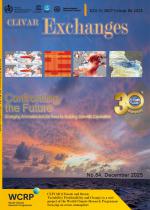Another Record: Ocean Warming Continues through 2021 despite La Niña Conditions

Figure: (upper) The global upper 2000 m OHC from 1958 through 2021. The histogram presents annual anomalies relative to a 1981–2010 baseline, with positive anomalies shown as red bars and negative anomalies as blue. Units: ZJ. (bottom) Detrended OHC time series from 2005 to 2021 compared with ONI index.
The increased concentration of greenhouse gases in the atmosphere from human activities traps heat within the climate system and increases ocean heat content (OHC). Over 90% Earth’s Energy Imbalance in the climate system is stored in the oceans, which leads to increased ocean vertical stratification, thermal expansion and sea level rise. The warmer ocean fuels increased frequency and intensity of tropical cyclones and extreme rainfalls, and thus threatens marine ecosystem and human livelihoods, e.g. coral reefs and fisheries.
A recent study published in Advances in Atmospheric Sciences (https://doi.org/10.1007/s00376-022-1461-3), led by Dr. Lijing Cheng, member of CLIVAR GSOP, provides the first analysis of recent OHC changes through 2021 from two international groups, i.e. IAP/CAS in China and NCEI/NOAA in the US. According to the study, the world ocean, in 2021, was the hottest ever recorded by humans, and the 2021 annual OHC value is even higher than last year’s record value by 14 ± 11 ZJ (1 zetta J = 1021 J) using the IAP/CAS dataset and by 16 ± 10 ZJ using NCEI/NOAA dataset. The long-term ocean warming is larger in the Atlantic and Southern Oceans than in other regions and is mainly attributed, via climate model simulations, to an increase in anthropogenic greenhouse gas concentrations.
The authors also made diagnosis of the drivers of OHC trend patterns, by using the Community Earth System Models Version 1 Large Ensemble (CESM1-LE) and Single-Forcing Large Ensemble (CESM1-SF). The contribution of Greenhouse Gas (GHG) is notably in nearly all regions to the observed ocean warming, and the industrial aerosols (AER), biomass aerosol (BMB) and land use and land cover (LULC) also contribute yet behave differently in the regional patterns of ocean warming. The basin wide changes and regional hot spots were also assessed in this study, as they are more relevant to community risk assessment and societal adaptation, than the global metrics.
This study also indicates that there are still uncertainties and knowledge gaps in monitoring ocean warming; for example, the quantification of uncertainty from inter-annual to multidecadal scales and the impact of data Quality Control (QC) and regional differences of OHCs revealed by different datasets.
(Summary prepared by Jing Li)
*******************************************
Cheng, L. J, and Coauthors, 2022: Another record: Ocean warming continues through 2021 despite La Niña conditions. Adv. Atmos. Sci., https://doi.org/10.1007/s00376-022-1461-3.











Add new comment